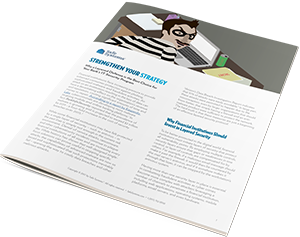5 Steps to Building a Strong Security Culture

Financial institutions face increasing pressure to provide enhanced consumer protection against phishing, sophisticated malware and fraudulent activities. Smaller organizations are the prime targets for calculated, malicious attacks, due to the sensitive financial data banks are responsible for.
Investing in technology resources is necessary to protect community banks from security breaches and attacks, but it is equally important to instill a strong security culture within the bank to help all departments and personnel adequately combat these threats. IT security is integral to running a successful institution, and banks should begin to educate and train their employees on the proper way to tackle security-related issues and safeguard customer information.
Here are 5 key steps community banks can take to protect their institutions and build a strong security culture.
- Determine Key Assets and Identify Where Vulnerabilities Lie
Design security that will protect your organization from an attack and be able to detect any security breach. This often involves implementing a layered security approach to protect all vulnerability points from different issues or risks. Having these layers ensures that any gaps or weaknesses in one control, or layer of controls, are compensated for by others.
- Adequately Train Staff
An important part of building a strong security culture is ensuring that all bank employees are comfortable highlighting security-related issues and will follow the appropriate steps to ensure they get resolved. This means staff must be adequately trained to spot security issues; they must understand the importance of protecting sensitive information and recognize the risks of mishandling this information. All employees should know how to handle customer data securely and be able to report anomalies, mistakes or any concerns immediately. In order to execute this, employees must be trained to understand what to look for; where key vulnerabilities lie; what steps to take when a security issue arises; and who they should alert.

- Instill the Concept that Security Responsibilities Belong to Everyone
The security department is not the only one responsible for security. Everyone in the organization is responsible, and everyone must understand their role and responsibilities. This does not mean just the C-suite, but executives all the way to tellers. When everyone is held accountable for the security of sensitive data, the bank staff is more equipped to handle the unexpected and protect the institution from harm.
- Raise Awareness of the Latest Security Threats
Raising awareness for the entire organization about the wide range of security threats helps to maximize security efforts. This can be done by role playing through threat scenarios or sending fake phishing emails to staff to not only test their awareness of issues, but also their ability to handle and spot issues. Training also plays a part here as well. By providing online training sessions and regular alerts and information about tips and tricks to improve security, you also ensure employees are up to date on the latest security threats and understand what they need to do when an attack occurs.
- Reward and Recognize Employees Who Do the Right Thing for Security
Rather than focus on the negative aspects of security, look for ways and opportunities to celebrate success. For example, when someone goes through your bank’s mandatory security awareness program and completes it successfully or spots a potential threat and takes the proper steps to negate it, it’s important to recognize their proactive behavior. This helps prove that everyone has a hand in security and a role to play in protecting the financial institution and its assets.
Strengthen Your Strategy: Why a Layered Defense is the Best Choice for Your Bank’s IT Security Program
Learn why a single layer of security, such as antivirus, is no longer enough in the current risk environment.

Establishing a strong security culture is an on-going activity to ensure a high level of awareness is maintained on a daily basis. When a security culture is established within a financial institution, all employees recognize and understand that they have a personal responsibility for safeguarding against breaches.
For more information please download our complimentary white paper, Strengthen Your Strategy: Why a Layered Defense is the Best Choice for Your Bank’s IT Security Program.


